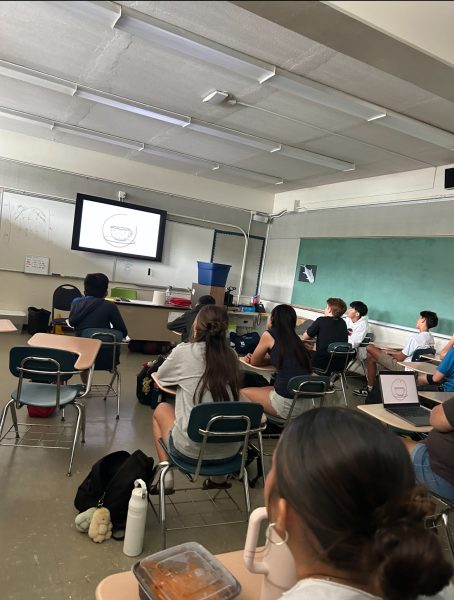Should dancers receive P.E. credit?
By Kayla Tom
Staff Writer
Dancers don’t get the credit they deserve. Being a dancer requires effort and artistry; something most people fail to consider with the belief that dancers are born with talent. , but most people just think dancers are somehow “naturally talented.”
The Mid-Pacific School of the Arts dance program covers a Physical Education credit, however, you have to do both contemporary and ballet for a total of 3 years for it to count as a full PE credit.
“I definitely think dance should be counted as a PE credit because I think we use the same amount of effort and even use more muscles and conditioning when you dance verses in PE,” said senior Rheylie Bennie.
Dance at Mid-Pacific pushes students capabilities by enhancing and improving coordination, flexibility, and balance. to improve, and it It can often be often can be even more physically demanding than certain PE courses. than PE. It also enhances and improves coordination, flexibility and balance.
“In comparison to athletes, dancers are more flexible, but I think that athletes have to be more athletic in a sense,” said freshman Bear Finch.
Sentiments like those Finch expressed are all too common and do not take into account the hard work, stamina, determination and athleticism required for dancers.
“If people don’t understand why dance is seen as physical as PE classes, I think that just means they don’t fully understand our program or dance itself”, said junior Kalena O’Connell.
Dance is a full body workout that people find fun. A 30 minute dance class burns between 130 and 250 calories, which is about the same as jogging. It’s good for your heart and it makes you stronger, while giving you the ability to express yourself and have artistic freedom.
“While I don’t take dance, I imagine that dance focuses more on elegance and flexibility as opposed to PE. Although, I would certainly enjoy dance and enjoy the benefits of doing it, such as being more flexible and knowing dance choreography,” said sophomore James Kaminer.
Dance offers more than elegance and flexibility; the versatilities of every dance genre offer differing levels of art and freedom. Its training is intense, requiring long hours that demand both physical and mental stamina.
“PE offers a more well respected credit because no one really questions PE by doing certain things to get exercise. People automatically associate exercise and fitness with PE and they see dance as what mainstream sees, like TikTok dances. People don’t see the behind the scenes and hard work of dance,” said Bennie.
MPSA certificate dancers work rigorously to perfect their craft using the same amount of athleticism required for their classes to meet the expectations to be a part of the MPSA program.
“Dancers have a different kind of dedication that I haven’t experienced with any other sport. Since there are no games or team goals, you work everyday for yourself striving for perfection, knowing you won’t ever get there,” said O’Connell.
The dance classes take up two periods of their schedules, meaning one class per day. The classes as of right now are 75 minutes each, which does not give the dancers enough time for a full class to learn.
“An issue with the dance program is that they’re shortening the periods to 75 minutes. Especially with ballet, you can’t fit what you need to fit in one class because it’s about an hour due to the changing and passing times,” said Bennie.
Since the 75 minute periods have changed from the 90 minute periods, it has had a negative impact on the dancers, as the teachers have noticed a decline in training, ability and skill. since the 75 minute periods have been replaced.
“Dancers usually put more effort into their dancing than students do into PE. This is because PE is usually only semi-serious, with the games being fairly short. However when you’re dancing, especially in front of a crowd for prolonged periods of time, I believe this motivates students to try harder and make sure they do well, causing them to exert themselves more,” said Kaminer.
Dance classes train different skills and athletic ability. Dance should not be looked down upon or compared to PE, but for them to be seen as equal in the level of the athletic skill that is required.
“It is more active than what you would do in PE. We’re drenched in sweat and there are no showers for us to use. All we have is our little changing rooms and then we have to rush to our next class, which I think is super unfair,” said Bennie.
In addition, there are many misconceptions about dance, particularly that dance doesn’t require much athleticism and that it is something only girls should partake in. Dance should be open to anyone regardless of their gender.
“I think that if people are more open minded and actually look into the benefits of dance, they’ll realize how beneficial it can be for them and their health,” said Kaminer.
As we understand that dance is an exercise, it fits into the definition of physical education. The definition of PE is: a course of formal instruction in exercise, developing physical fitness and the ability to perform and enjoy day-to-day physical activities with ease.
“What’s special about dance is it is an art form that requires intensive athletic ability and dedication, just like any other sport or physical activity. At MPSA, we create a community that grows together, just doing what we all love to do with our closest friends,” said O’Connell.










